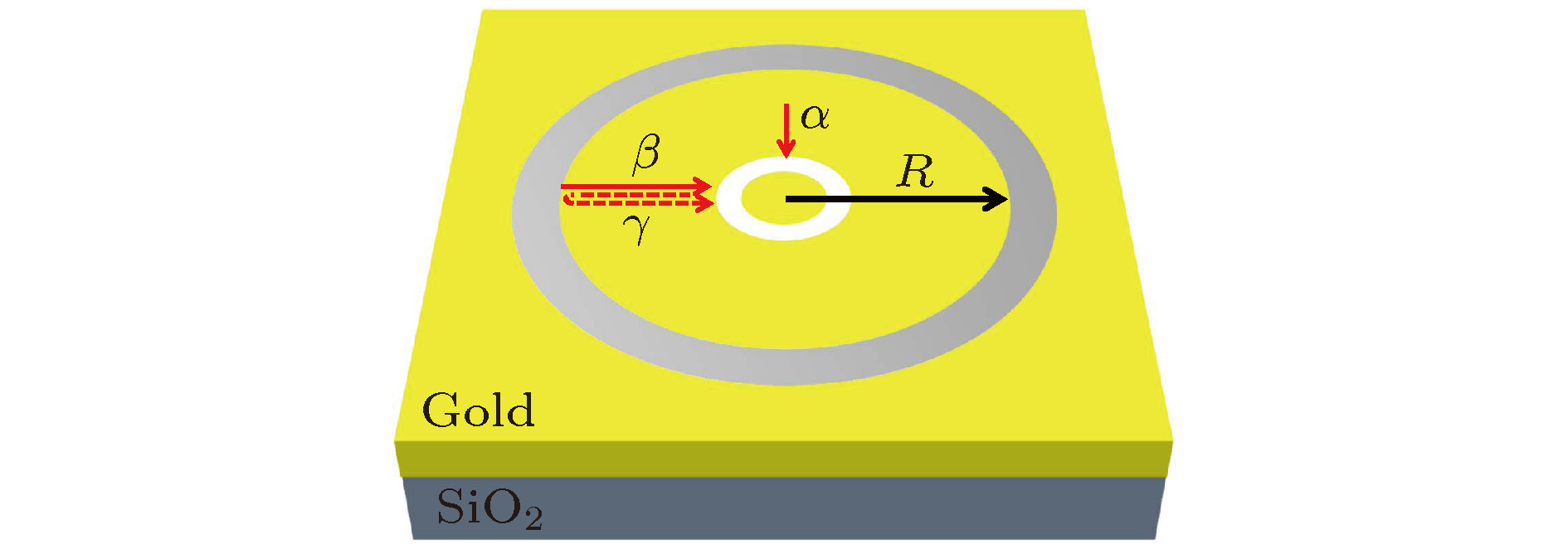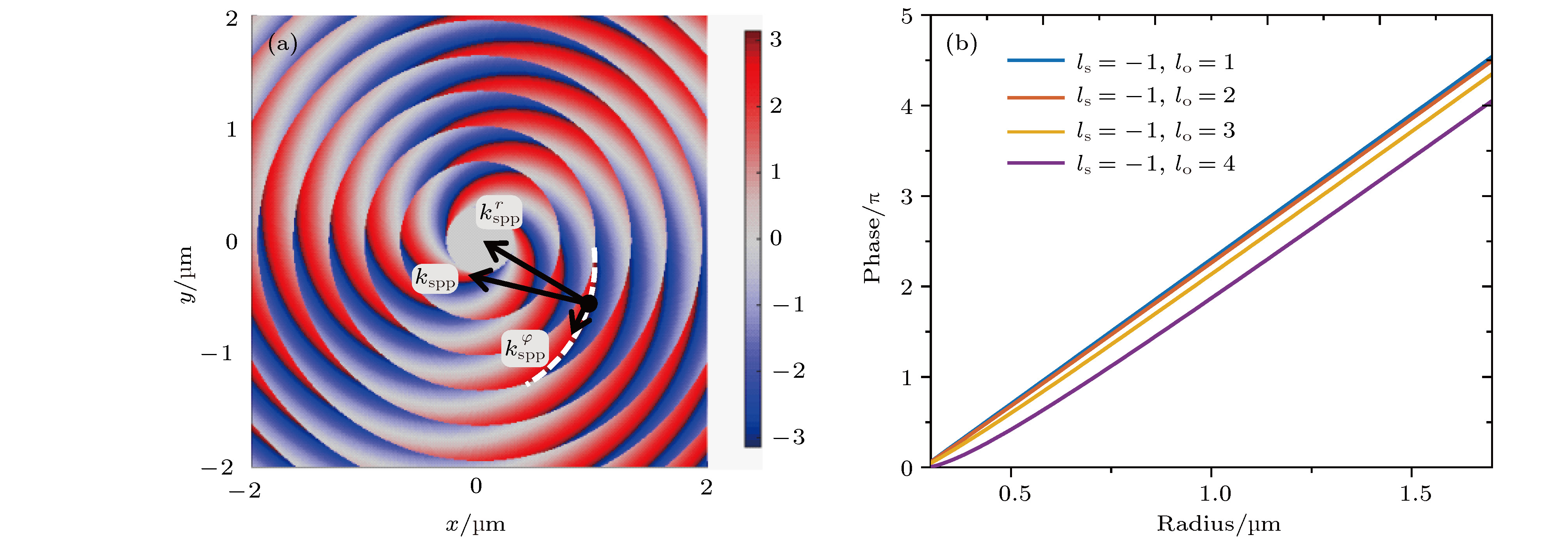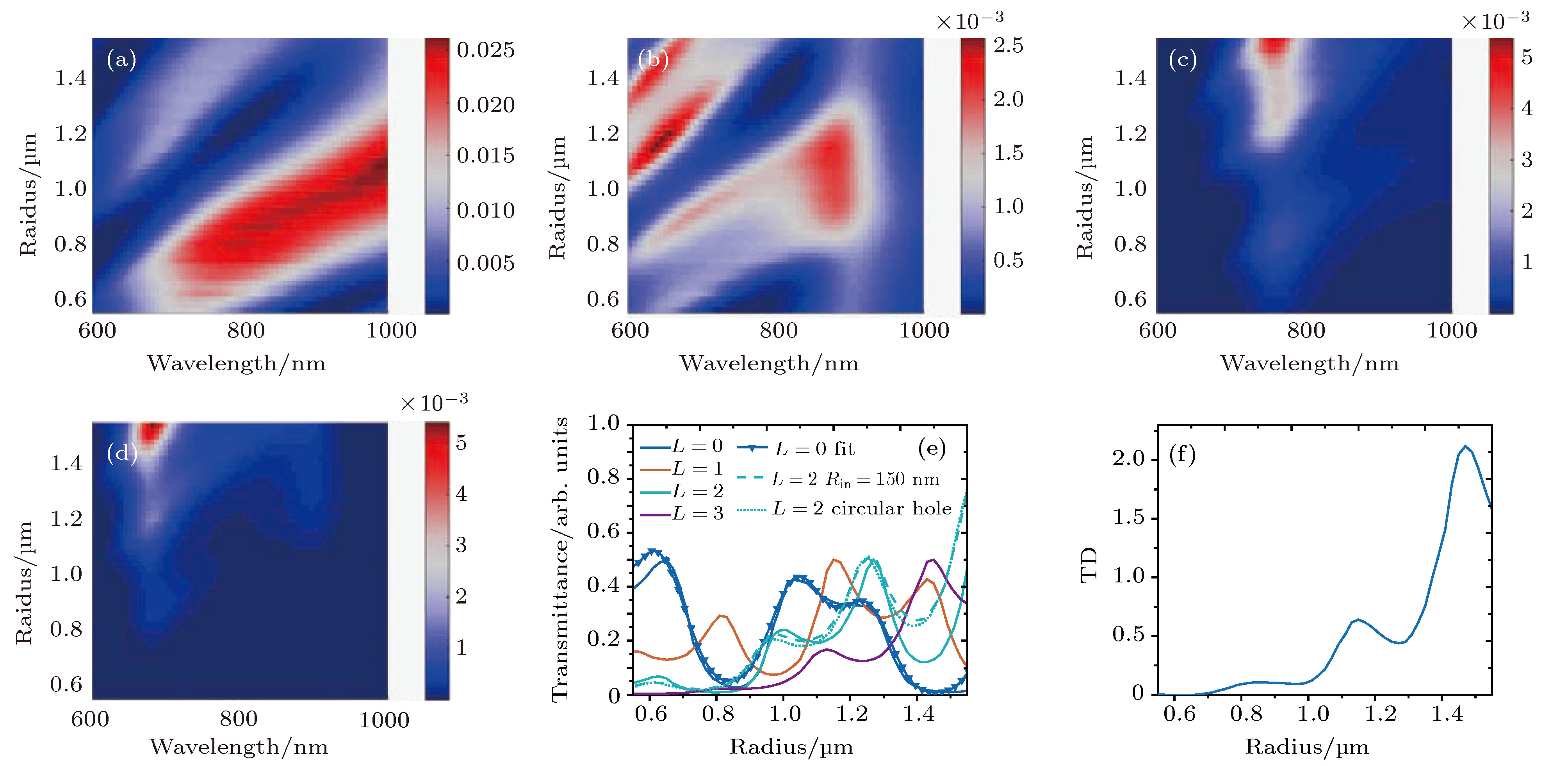-
在环形凹槽包围环形金属纳米孔的异常透射器件的研究中, 环形凹槽可以将携带光子角动量的入射光转化为涡旋表面等离极化激元, 这些涡旋表面等离极化激元传向几何中心并与直接照射在环形纳米孔上的光子发生干涉, 当相互干涉的光子满足相位匹配条件时, 环形纳米孔的透射率得到显著增强. 本文利用理论分析和数值计算的方法研究了光子角动量和凹槽半径对环形纳米孔透射过程的影响. 我们发现调节环形凹槽的半径和入射光携带的光子角动量可以调节光子在金膜上表面传输时的径向传播相位, 进而影响了环形纳米孔附近的干涉电场强度, 最终决定了环形纳米孔的透射率, 进而可以通过调节凹槽的半径来调节携带不同光子角动量的光束在环形纳米孔的透射率. 本文的研究结果对基于涡旋表面等离极化激元的异常透射器件的设计具有重要的指导意义.The nano groove can highly improve the transmittance of coaxial nanoring aperture due to the excitation of surface plasmon polariton (SPP). The total angular momentum carried by incident beam is reserved in the whole process and transferred to the SPP, thus the vortex SPP carrying orbital angular momentum is generated. The enhanced transmittance of nano aperture by vortex SPP has a wide range of applications, but its physical mechanism has been ignored for a long time. Here we study the process of the enhanced transmittance of the coaxial nanoring aperture and provide a model to describe the process of photon transmission. When the incident light irradiates on the coaxial nanoring aperture and nano groove, the vortex SPP induced by the groove propagates to coaxial nanoring aperture. Some of the photons in the SPP are coupled into the coaxial nanoring aperture and some are reflected back. The reflected photons travel back and forth multiple times between the coaxial nanoring aperture and nano groove. The vortex SPP interacts with the incident beam at the round of coaxial nanoring aperture, which determines the intensity at the round of the coaxial nano aperture, and thus affecting the transmittance. We systematically study the influence of optical angular momentum and the radius of the nano groove on the transmittance of coaxial nanoring aperture by using theoretical analysis and numerical simulations. The results show that the optical angular momentum and radius of the nano groove both affect the radial propagation phase of vortex SPP from nano groove to coaxial nanoring aperture, hence affecting the intensity of the electric field at the round of coaxial nanoring aperture and consequently determine the transmittance. The transmittance peaks of incident beams with different optical angular momenta will appear at different radii of the nano grooves, which provides a potential way to modulate the transmittance by adjusting the radius of the nano groove. This study is instructive for designing the enhanced optical transmission nano device based on vortex SPP.
[1] Ebbesen T W, Lezec H J, Ghaemi H F, Thio T, Wolff P A 1998 Nature 391 667
 Google Scholar
Google Scholar
[2] Thio T, Pellerin K M, Linke R A, Lezec H J, Ebbesen T W 2001 Opt. Lett. 26 1972
 Google Scholar
Google Scholar
[3] Carretero-Palacios S, Mahboub O, Garcia-Vidal F, Martin-Moreno L, Rodrigo S G, Genet C, Ebbesen T 2011 Opt. Express 19 10429
 Google Scholar
Google Scholar
[4] Zilio P, Mari E, Parisi G, Tamburini F, Romanato F 2012 Opt. Lett. 37 3234
 Google Scholar
Google Scholar
[5] Zilio P, Parisi G, Garoli D, Carli M, Romanato F 2014 Opt. Lett. 39 4899
 Google Scholar
Google Scholar
[6] Ren H, Li X, Zhang Q, Gu M 2016 Science 352 805
 Google Scholar
Google Scholar
[7] Deng Z L, Zhang S, Wang G P 2016 Nanoscale 8 1588
 Google Scholar
Google Scholar
[8] Liu A P, Xiong X, Ren X F, Cai Y J, Rui G H, Zhan Q W, Guo G C, Guo G P 2013 Sci. Rep. 3 2402
 Google Scholar
Google Scholar
[9] Catrysse P B, Fan S 2009 Appl. Phys. Lett. 94 231111
 Google Scholar
Google Scholar
[10] Burgos S P, De Waele R, Polman A, Atwater H A 2010 Nat. Mater. 9 407
 Google Scholar
Google Scholar
[11] Allen L, Beijersbergen M W, Spreeuw R J, Woerdman J P 1992 Phys. Rev. A 45 8185
 Google Scholar
Google Scholar
[12] Wang L L, Ren X F, Yang R, Guo G C, Guo G P 2009 Appl. Phys. Lett. 95 11
[13] Gorodetski Y, Niv A, Kleiner V, Hasman E 2008 Phys. Rev. Lett. 101 043903
 Google Scholar
Google Scholar
[14] Yang S, Chen W, Nelson R L, Zhan Q 2009 Opt. Lett. 34 3047
 Google Scholar
Google Scholar
[15] Chen W, Abeysinghe D C, Nelson R L, Zhan Q 2010 Nano Lett. 10 2075
 Google Scholar
Google Scholar
[16] Cho S W, Park J, Lee S Y, Kim H, Lee B 2012 Opt. Express 20 10083
 Google Scholar
Google Scholar
[17] Liu A, Rui G, Ren X, Zhan Q, Guo G, Guo G 2012 Opt. Express 20 24151
 Google Scholar
Google Scholar
[18] Tsai W Y, Huang J S, Huang C B 2014 Nano Lett. 14 547
 Google Scholar
Google Scholar
[19] Tischler N, Fernandezcorbaton I, Zambranapuyalto X, Minovich A, Vidal X, Juan M L, Molinaterriza G 2014 Light-Sci. Appl. 3 e183
 Google Scholar
Google Scholar
[20] Zambranapuyalto X, Vidal X, Molinaterriza G 2014 Nat. Commun. 5 4922
 Google Scholar
Google Scholar
[21] Wang S, Deng Z L, Cao Y, Hu D, Xu Y, Cai B, Jin L, Bao Y, Wang X, Li X 2018 IEEE Photonics J. 10 1
[22] Johnson P B, Christy R W 1972 Phys. Rev. B 6 4370
 Google Scholar
Google Scholar
[23] Gorodetski Y, Shitrit N, Bretner I, Kleiner V, Hasman E 2009 Nano Lett. 9 3016
 Google Scholar
Google Scholar
[24] Mahboub O, Palacios S C, Genet C, Garcia-Vidal F J, Rodrigo S G, Martin-Moreno L, Ebbesen T W 2010 Opt. Express 18 11292
 Google Scholar
Google Scholar
-
图 1 纳米结构示意图. 厚度为D = 150 nm的金膜上刻蚀有宽度为100 nm、深度为100 nm的环形凹槽, 半径为R; 在凹槽的中心处有环形纳米孔, 环形纳米孔的内外半径分别为rin = 250 nm和rout = 300 nm, 深度与金膜的厚度相等, 形成穿孔
Fig. 1. The schematic of nano structure: An annular nano groove having a width of 100 nm and a depth of 100 nm is etched on the gold film having a thickness of D = 150 nm, the coaxial nanoring aperture with the inner and outer radii are rin = 250 nm and rout = 300 nm is located in the center of the nano groove.
图 2 波长为800 nm时, 携带不同轨道角动量的左旋圆偏振入射光(ls = –1)的强度分布情况及电场分量Ex的相位分布情况 (a) lo = 1对应的强度分布; (b) lo = 2对应的强度分布; (c) lo = 3对应的强度分布; (d) lo = 4对应的强度分布; (e) lo = 1对应的相位分布; (f) lo = 2对应的相位分布; (g) lo = 3对应的相位分布; (h) lo = 4对应的相位分布.随着携带的轨道角动量拓扑核数逐渐增加, 入射光光斑逐渐变大
Fig. 2. The intensity distribution and the phase distribution of the Ex component of the incident beams (ls = –1) at the wavelength of 800 nm: (a) The intensity distribution (lo = 1); (b) the intensity distribution(lo = 2); (c) the intensity distribution(lo = 3); (d) the intensity distribution(lo = 4); (e) the phase distribution (lo = 1); (f) the phase distribution (lo = 2); (g) the phase distribution (lo = 3); (h) the phase distribution (lo = 4). The light spot is increasing with the topological number of the orbital angular momentum
图 3 波长为650 nm时 (a)入射光携带有光子总角动量L = 3 (ls = –1, lo = 4)时, 在金膜上表面激发的涡旋表面等离极化激元中电场分量
$E_z^{{\rm{spp}}}$ 的相位图; (b)在选定的四种左旋圆偏振的照射下, 激发的涡旋表面等离极化激元在金膜上表面的传输时的径向传播相位φrFig. 3. (a) The phase distribution of the
$E_z^{{\rm{spp}}}$ component of the surface plasmon polariton when the topological number of the total angular momentum carried by the incident beam at the wavelength of 650 nm equals to 3 (ls = –1, lo = 4); (b) the radical propagation phase φr of the surface plasmon polariton(SPP) when the nanostructure is irradiated by the selected four incident beams (ls = –1, lo = 1, 2, 3, 4).图 4 (a)—(d)在选定的四种左旋圆偏振光(ls = –1, lo = 1, 2, 3, 4)的照射下, 透射率与环形凹槽半径和波长的变化关系; (e)波长为650 nm时, 透射率随凹槽半径的变化曲线; (f)光子总角动量为3(ls = –1, lo = 4)的光束透射率与光子总角动量为2(ls = –1, lo = 3)的光束透过率之间的差值
Fig. 4. (a)−(d) The relation of the transmittance to wavelength of incident beams and radius of the nano groove; (e) the curves of the transmission with radius of the nano groove when wavelength equals to 650 nm; (f) the difference between transmittance of total angular momentum topological number of 3 (ls = –1, lo = 4)and 2 (ls = –1, lo = 3)
-
[1] Ebbesen T W, Lezec H J, Ghaemi H F, Thio T, Wolff P A 1998 Nature 391 667
 Google Scholar
Google Scholar
[2] Thio T, Pellerin K M, Linke R A, Lezec H J, Ebbesen T W 2001 Opt. Lett. 26 1972
 Google Scholar
Google Scholar
[3] Carretero-Palacios S, Mahboub O, Garcia-Vidal F, Martin-Moreno L, Rodrigo S G, Genet C, Ebbesen T 2011 Opt. Express 19 10429
 Google Scholar
Google Scholar
[4] Zilio P, Mari E, Parisi G, Tamburini F, Romanato F 2012 Opt. Lett. 37 3234
 Google Scholar
Google Scholar
[5] Zilio P, Parisi G, Garoli D, Carli M, Romanato F 2014 Opt. Lett. 39 4899
 Google Scholar
Google Scholar
[6] Ren H, Li X, Zhang Q, Gu M 2016 Science 352 805
 Google Scholar
Google Scholar
[7] Deng Z L, Zhang S, Wang G P 2016 Nanoscale 8 1588
 Google Scholar
Google Scholar
[8] Liu A P, Xiong X, Ren X F, Cai Y J, Rui G H, Zhan Q W, Guo G C, Guo G P 2013 Sci. Rep. 3 2402
 Google Scholar
Google Scholar
[9] Catrysse P B, Fan S 2009 Appl. Phys. Lett. 94 231111
 Google Scholar
Google Scholar
[10] Burgos S P, De Waele R, Polman A, Atwater H A 2010 Nat. Mater. 9 407
 Google Scholar
Google Scholar
[11] Allen L, Beijersbergen M W, Spreeuw R J, Woerdman J P 1992 Phys. Rev. A 45 8185
 Google Scholar
Google Scholar
[12] Wang L L, Ren X F, Yang R, Guo G C, Guo G P 2009 Appl. Phys. Lett. 95 11
[13] Gorodetski Y, Niv A, Kleiner V, Hasman E 2008 Phys. Rev. Lett. 101 043903
 Google Scholar
Google Scholar
[14] Yang S, Chen W, Nelson R L, Zhan Q 2009 Opt. Lett. 34 3047
 Google Scholar
Google Scholar
[15] Chen W, Abeysinghe D C, Nelson R L, Zhan Q 2010 Nano Lett. 10 2075
 Google Scholar
Google Scholar
[16] Cho S W, Park J, Lee S Y, Kim H, Lee B 2012 Opt. Express 20 10083
 Google Scholar
Google Scholar
[17] Liu A, Rui G, Ren X, Zhan Q, Guo G, Guo G 2012 Opt. Express 20 24151
 Google Scholar
Google Scholar
[18] Tsai W Y, Huang J S, Huang C B 2014 Nano Lett. 14 547
 Google Scholar
Google Scholar
[19] Tischler N, Fernandezcorbaton I, Zambranapuyalto X, Minovich A, Vidal X, Juan M L, Molinaterriza G 2014 Light-Sci. Appl. 3 e183
 Google Scholar
Google Scholar
[20] Zambranapuyalto X, Vidal X, Molinaterriza G 2014 Nat. Commun. 5 4922
 Google Scholar
Google Scholar
[21] Wang S, Deng Z L, Cao Y, Hu D, Xu Y, Cai B, Jin L, Bao Y, Wang X, Li X 2018 IEEE Photonics J. 10 1
[22] Johnson P B, Christy R W 1972 Phys. Rev. B 6 4370
 Google Scholar
Google Scholar
[23] Gorodetski Y, Shitrit N, Bretner I, Kleiner V, Hasman E 2009 Nano Lett. 9 3016
 Google Scholar
Google Scholar
[24] Mahboub O, Palacios S C, Genet C, Garcia-Vidal F J, Rodrigo S G, Martin-Moreno L, Ebbesen T W 2010 Opt. Express 18 11292
 Google Scholar
Google Scholar
计量
- 文章访问数: 12419
- PDF下载量: 71
- 被引次数: 0














 下载:
下载:





